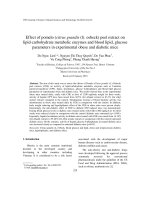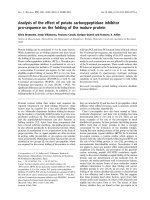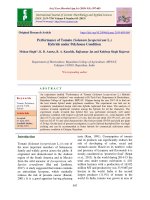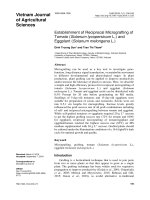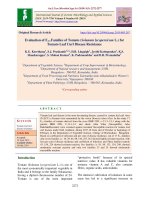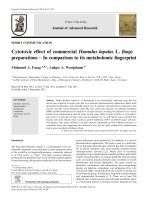Effect of split application of nitrogen and potassium on growth and yield of potato (Solanum tuberosum L.)
Bạn đang xem bản rút gọn của tài liệu. Xem và tải ngay bản đầy đủ của tài liệu tại đây (270.65 KB, 6 trang )
Int.J.Curr.Microbiol.App.Sci (2019) 8(2): 3088-3093
International Journal of Current Microbiology and Applied Sciences
ISSN: 2319-7706 Volume 8 Number 02 (2019)
Journal homepage:
Original Research Article
/>
Effect of Split Application of Nitrogen and Potassium on Growth and
Yield of Potato (Solanum tuberosum L.)
Purnendu Sekhar Bera1, Priyanka Das1, Champak Kumar Kundu1*, Utpal Biswas1,
Hirak Banerjee1 and Pratap Kumar Dhara2
1
Department of Agronomy, Faculty of Agriculture, 2Department of Soil and Water
Conservation, Faculty of Agriculture, Bidhan Chandra Krishi Viswavidyalaya, Mohanpur,
Nadia, West Bengal- 741252, India
*Corresponding author
ABSTRACT
Keywords
Nitrogen,
Potassium, Tuber
yield, Potato
Article Info
Accepted:
22 January 2019
Available Online:
10 February 2019
A field experiment was carried out during rabi season of 2013-14at Instructional Farm,
Bidhan Chandra Krishi Viswavidyalaya, Jaguli, Mohanpur, Nadia, West Bengal to study
the effect of different doses of nitrogen and potassium fertilizer on growth and yield of
potato. The experiment was conducted under randomized block design replicated thrice.
Two different doses of N:P2O5:K2O i.e. 300:150:150 and 200:150:150 kg ha -1respectively
were applied. Further N:P2O5:K2O-200:150:150 kg ha-1were split in nitrogen and
potassium fertilizer at basal, 28 and 42 DAP along with full dose of phosphatic fertiliser at
basal and altogether ten treatments were tested under the experiment. Results revealed that
highest growth attributes and yield namely plant height (36.17 cm), LAI (3.12), CGR
(40.04g ma-2 day-1), NAR (6.04g ma-2 day-1) and LAD (132.53 days) and tuber yield
(28.917 t ha-1) were recorded in case of the treatment where N and K 2O applied as basal +
1/4 at 28 and 42 DAP @ 200:150:150 N:P 2O5:K2O kg ha-1. Amongst the ten treatments
adopted in the experiment, the highest net return ha-1 (Rs.78860.31) and highest return per
rupee investment (1.83) were obtained from the treatment where N and K 2O were applied
as basal + 1/4th at 28 and 42 DAP @ 200:150:150 N:P 2O5:K2O kg ha-1.
Introduction
Potato (Solanum tuberosum L.) is an
important member of the family Solanaceae.
It is grown and consumed all around the
world and is one of the main vegetable cash
crop. Potato is an integral part of human diet.
The area and production of potato in the
country during 2016-17was estimated around
21.64 lakhs ha and 465.46lakhs MT
respectively (Hort. Stat., 2017). The major
potato growing states are Uttar Pradesh, West
Bengal, Punjab, Bihar, Haryana, Madhya
Pradesh, Gujarat and Maharashtra. West
Bengal ranks second in potato production
after Uttar Pradesh, in the country. In West
Bengal, it is grown in 0.42 million ha area
with the production of 11.05 million tones
during 2016-17(Hort. Stat., 2017). Potatoes
require high amounts of potassium (K) and
3088
Int.J.Curr.Microbiol.App.Sci (2019) 8(2): 3088-3093
nitrogen (N) fertilizers for optimum growth,
production and tuber quality. In the eastern
plains severe imbalance in the N: P: K
application ratio and unbalanced fertilization
in favour of N and lack of potash application
is quite common among farmers (Singh and
Rai, 2011). Nitrogen and Potassium are
important essential macronutrients which play
important role in growth and development of
potato crop. Inadequate N fertilization leads
to poor potato growth and yield while
excessive N application leads to delayed
maturity, poor tuber quality, and occasionally
a reduction in tuber yield (Cerny et al., 2010).
With rising environmental concerns for N
fertilizer management practices, efficient N
use is important for the economic
sustainability of cropping systems (Shrestha
et al., 2010).In addition to N and P, potato is a
heavy remover of soil potassium and its
response to potassium varies with variety,
source and method of potassium fertilizer
application (Sharma and Sud, 2001; Kumar et
al., 2007).
Materials and Methods
The experiment was carried out during rabi
season of 2013-14at the Instructional Farm,
Bidhan Chandra Krishi Viswavidyalaya,
Jaguli, Nadia, West Bengal. The farm was
situated at 22093/N latitude and 830 59/ E
longitude at an elevation of 9.75 m above
mean sea level. This zone falls under the subtropical humid climate where summer and
winter both are short and mild/moderate. So,
this zone is not subjected to condition of
extreme winter. The total rainfall received
during the winter months (Nov-Feb) i.e.,
experimental period was 19.4 mm and that
occurred in the month of February. The
maximum and minimum temperature during
this period ranged from 23.6-280C and 10.115.90C respectively (Table 1). During the
investigation period, the maximum and
minimum relative humidity varied from 95.497.3% and 52.1-61.4% respectively and very
low rainfall (9.7 mm, respectively) occurred
in the month of February (Table 1). The
experiment was laid out in randomized block
design with ten treatments and three
replications. The dose N:P2O5:K2O was
300:150:150 (kg ha-1) for T1 (farmer’s
practice) treatment where fertilisers applied as
1/2 N as basal + 1/2 N at 28 DAP and full K
as basal. For rest nine treatments N:P2O5:K2O
dose was 300:150:150 (kg ha-1). These
treatments are T2- 1/2 N as basal + 1/2 N at 28
DAP and full K as basal, T3- 1/2 N as basal +
1/4 N at 28 DAP +1/4 N at 42 DAP and full K
as basal, T4- 1/3 N as basal + 1/3 N at 28 DAP
+ 1/3 N at 42 DAP and full K as basal, T5- 1/2
N as basal +1/2 N at 28 DAP and 1/2 K as
basal + 1/2 K at 28 DAP, T6- 1/2 N as basal +
1/4 N at 28 DAP + 1/4 N at 42 DAP and 1/2
K as basal + 1/2 K at 28 DAP, T7- 1/3 N as
basal + 1/3 N at 28 DAP + 1/3 N at 42 DAP
and1/2 K as basal + 1/2 K at 28 DAP, T8-1/2
N as basal +1/2 N at 28 DAP and1/2 K as
basal + 1/4 K at 28 DAP + 1/4 K at 42 DAP,
T9- 1/2 N as basal + 1/4 N at 28 DAP + 1/4 N
at 42 DAP and 1/2 K as basal + 1/4 K at 28
DAP + 1/4 K at 42 DAP, T10(N:P2O5:K2O kg
ha-1- 200:150:150)- 1/3 N as basal + 1/3 N at
28 DAP + 1/3 N at 42 DAP and 1/3 K as
basal + 1/3 K at 28 DAP + 1/3 K at 42 DAP.
All phosphatic fertiliser was applied as basal
to all plots. The source of nitrogen,
phosphorus and potassium were Urea, SSP
and MOP respectively. The potato variety
used for the experiment was Kufri Jyoti. The
tubers of potato were planted on 22nd
November, 2013 with 50 cm X 20 cm
spacing. Seed tuber was treated with Dithane
M-45 @ 2.5 g l-1 of water before sowing.
Irrigation was given as per requirement of the
crop. The treatments were allocated randomly
to different plots with the help of random
number table (Fisher, R. A., 1958) and the
data were analysed by ANOVA, and ranked
by using the critical differences (CD) at 5%
level.
3089
Int.J.Curr.Microbiol.App.Sci (2019) 8(2): 3088-3093
Results and Discussion
Application of both nitrogen and potassium
influenced the growth attributes and yield
components of potato. In case of height of
potato plant, during 80 DAP the maximum
height (36.17 cm) was observed by the
treatment T9 where both N and K applied in
three splits i.e. 1/2 as basal + 1/4 at 28 DAP +
1/4 at 42 DAP. These results supported by the
finding of Ahmed et al., (2017). The leaf area
index (LAI) recorded highest value (3.12)
under the same treatment.
Marton (2001) and Saha et al., (2001) also
observed increased foliage and LAI with N
and K application. The treatment with three
splitting of nitrogen and potassium (1/2 as
basal + 1/4 at 28 DAP + 1/4 at 42 DAP) also
maintained the highest value of CGR (40.04 g
m-2 day-1) and tuber bulking rate (43.17 g m-2
day-1) between 60-80 DAP.
The highest leaf area duration (132.53 days)
and net assimilation rate (6.04 g m-2 day-1)
was recorded in T9 within 60-80 DAP.
Moshileh et al., (2005) reported that splitting
N rates into three doses improved plant
growth characters. A similar finding was also
reported by Rizk et al., (2013) (Table 2).
Regarding the grade wise yield, the maximum
(4.68 t ha-1) yield of less than 25 g size was
recorded in the treatment T9 where both N
and K applied in three splits (1/2 as basal +
1/4 at 28 DAP + 1/4 at 42 DAP). The highest
yield (6.27 t ha-1) of 25-50 g size tubers was
recorded under same treatment (Table 3).
For 51-75 g size tuber, the maximum yield
(8.17 t ha-1) was obtained from treatment T10
where both N and K was applied in three
splits (1/3 as basal + 1/3 at 28 DAP + 1/3 at
42 DAP). Production of large size tubers
(greater than 75 g) was recorded maximum
value (9.98 t ha-1) in treatment T9 and lowest
yield (7.93 t ha-1) was observed in treatment
T1 (farmer’s practice).Singh and Lal (2012)
reported improved tuber size by increasing
the large and medium grade yield and
decreasing the small and very small sized
tuber with N and K application. These results
supported by the finding of Kumar and
Trehan (2012).
The total tuber yield was recorded highest in
case of treatment T9(28.91 t ha-1) where both
N and K applied in three splits (1/2 as basal +
1/4 at 28 DAP + 1/4 at 42 DAP) and it was
closely followed by treatment T10 (27.61 t
ha-1) where both N and K was applied in three
splits (1/3 as basal + 1/3 at 28 DAP + 1/3 at
42 DAP). The lowest tuber yield (22.14 t ha-1)
was recorded in treatment T1 (farmer’s
practice) where N (300 kg ha-1) applied in two
splits (1/2 as basal + 1/2 at 28 DAP) and full
K (150 kg ha-1) as basal (Table 3).
The application of K to potato along with N is
very essential to improve tuber yield and its
quality (Singh and Lal, 2012).
Amongst the ten treatments adopted in the
experiment, the highest net return ha-1 (Rs.
78860.31) and highest return per rupee
investment (1.83) were obtained in T9
treatment where both N and K applied in
three splits (1/2 as basal + 1/4 at 28 DAP +
1/4 at 42 DAP). The lowest net return (Rs.
37055.27) and return per rupee investment
(1.39) were recorded in treatment T1 (farmer’s
practice) where N (300 kg ha-1) applied in two
splits (1/2 as basal + 1/2 at 28 DAP) and full
K (150 kg ha-1) as basal (Table 3). Therefore,
the balanced use of nutrients could be the
most accepted treatment to obtain maximum
benefit from the potato (Singh et al., 2010).
It can be concluded that split application of
nitrogen as well as potassium was found
better for giving higher growth, tuber yield
and net return.
3090
Int.J.Curr.Microbiol.App.Sci (2019) 8(2): 3088-3093
Table.1 Meteorological data of the experimental site during the period of investigation
Months
November, 2013
December, 2013
January, 2014
February, 2014
Temperature (0C)
Maximum
Minimum
28
15.9
25.9
12.7
23.6
10.1
27.1
13.8
Relative humidity (%)
Maximum
Minimum
96
52.1
97.3
57.5
95.4
61.4
95.4
52.5
Rainfall
(mm)
0
0
0
9.7
Source: Department of Agricultural Physics and Meteorology, B.C.K.V., Mohanpur, Nadia, W.B.
Table.2 Effect of split application of nitrogen and potassium on plant height, Leaf area index, Crop growth rate, Tuber bulking rate,
Leaf area duration and Net assimilation rate of potato
Treatments
T1
T2
T3
T4
T5
T6
T7
T8
T9
T10
S.Em+
CD at 5%
Plant height (cm)
at 80 DAP
LAI at 80 DAP
CGR (g ma-2 day1
) at 60-80 DAP
TBR (g ma-2 day1
) at 60-80 DAP
LAD (days) at 6080 DAP
NAR (g ma-2 day1
) at 60-80 DAP
34.80
32.53
33.03
33.37
32.40
32.73
33.90
32.63
36.17
34.50
0.421
1.249
2.08
2.54
2.57
2.84
2.85
2.86
2.88
2.92
3.12
2.96
0.017
0.047
19.37
23.45
24.31
26.66
27.42
27.99
28.07
28.88
40.04
33.29
0.189
0.564
23.45
25.17
25.43
27.23
27.79
29.17
29.33
34.19
43.17
39.60
1.341
3.984
71.33
83.07
86.20
90.67
92.87
98.53
100.53
107.13
132.53
125.00
1.674
4.973
5.43
5.65
5.64
5.89
5.91
5.68
5.59
5.39
6.04
5.34
0.088
0.263
DAP: Days after planting; LAI: Leaf area index; CGR: Crop growth rate; TBR: Tuber bulking rate; LAD: Leaf area duration; NAR: Net assimilation rate
T1 (N:P:K kg ha-1- 300:150:150)- 1/2 N as basal + 1/2 N at 28 DAP and full K as basal; T 2 (N:P:K kg ha-1- 200:150:150)- 1/2 N as basal + 1/2 N at 28 DAP and full K as basal; T3
(N:P:K kg ha-1- 200:150:150)- 1/2 N as basal + 1/4 N at 28 DAP +1/4 N at 42 DAP and full K as basal; T 4 (N:P:K kg ha-1- 200:150:150)- 1/3 N as basal + 1/3 N at 28 DAP + 1/3 N
at 42 DAP and full K as basal; T5 (N:P:K kg ha-1- 200:150:150)- 1/2 N as basal +1/2 N at 28 DAP and 1/2 K as basal + 1/2 K at 28 DAP; T 6 (N:P:K kg ha-1- 200:150:150)- 1/2 N as
basal + 1/4 N at 28 DAP + 1/4 N at 42 DAP and 1/2 K as basal + 1/2 K at 28 DAP; T 7 (N:P:K kg ha-1- 200:150:150)- 1/3 N as basal + 1/3 N at 28 DAP + 1/3 N at 42 DAP and1/2
K as basal + 1/2 K at 28 DAP; T8 (N:P:K kg ha-1- 200:150:150)-1/2 N as basal +1/2 N at 28 DAP and1/2 K as basal + 1/4 K at 28 DAP + 1/4 K at 42 DAP; T 9 (N:P:K kg ha-1200:150:150)- 1/2 N as basal + 1/4 N at 28 DAP + 1/4 N at 42 DAP and 1/2 K as basal + 1/4 K at 28 DAP + 1/4 K at 42 DAP; T 10 (N:P:K kg ha-1- 200:150:150)- 1/3 N as basal
+ 1/3 N at 28 DAP + 1/3 N at 42 DAP and 1/3 K as basal + 1/3 K at 28 DAP + 1/3 K at 42 DAP.
Full dose of phosphorus applied as basal.
3091
Int.J.Curr.Microbiol.App.Sci (2019) 8(2): 3088-3093
Table.3 Effect of split application of nitrogen and potassium on Yield and Economics rate of potato
Treatments
T1
T2
T3
T4
T5
T6
T7
T8
T9
T10
S.Em+
CD at 5%
Grade wise yield (t ha-1)
<25 g 25-50 g 51-75 g >75 g
3.000
3.007
0.793
2.900
3.997
3.863
3.730
3.620
4.687
4.203
0.0991
0.2944
4.833
5.500
4.783
4.900
4.813
5.640
5.457
5.823
6.277
5.673
0.1416
0.4208
6.373
6.473
6.587
7.317
7.300
7.023
7.320
6.733
7.967
8.173
0.1687
0.5013
7.933
8.133
8.100
8.720
8.167
8.237
8.567
8.973
9.987
9.567
0.1897
0.5635
Total yield
(t ha-1)
22.140
23.113
23.263
23.837
24.277
24.763
25.073
25.150
28.917
27.617
0.3875
1.1514
Total cost of
cultivation
(Rs. ha-1)
95784.73
94474.69
94474.69
94474.69
94474.69
94474.69
94641.69
94641.69
94641.69
94641.69
-
Gross return
(Rs. ha-1)
Net return
(Rs. ha-1)
B:C ratio
132840
138678
139578
143022
145662
148578
150438
150900
173502
165702
-
37055.27
44203.31
45103.31
48547.31
51187.31
54103.31
55796.31
56258.31
78860.31
71060.31
-
1.39
1.47
1.48
1.51
1.54
1.57
1.59
1.59
1.83
1.75
-
T1 (N:P:K kg ha-1- 300:150:150)- 1/2 N as basal + 1/2 N at 28 DAP and full K as basal; T2 (N:P:K kg ha-1- 200:150:150)- 1/2 N as
basal + 1/2 N at 28 DAP and full K as basal; T3 (N:P:K kg ha-1- 200:150:150)- 1/2 N as basal + 1/4 N at 28 DAP +1/4 N at 42 DAP
and full K as basal; T4 (N:P:K kg ha-1- 200:150:150)- 1/3 N as basal + 1/3 N at 28 DAP + 1/3 N at 42 DAP and full K as basal; T5
(N:P:K kg ha-1- 200:150:150)- 1/2 N as basal +1/2 N at 28 DAP and 1/2 K as basal + 1/2 K at 28 DAP; T6 (N:P:K kg ha-1200:150:150)- 1/2 N as basal + 1/4 N at 28 DAP + 1/4 N at 42 DAP and 1/2 K as basal + 1/2 K at 28 DAP; T7 (N:P:K kg ha-1200:150:150)- 1/3 N as basal + 1/3 N at 28 DAP + 1/3 N at 42 DAP and1/2 K as basal + 1/2 K at 28 DAP; T8 (N:P:K kg ha-1200:150:150)-1/2 N as basal +1/2 N at 28 DAP and1/2 K as basal + 1/4 K at 28 DAP + 1/4 K at 42 DAP; T9 (N:P:K kg ha-1200:150:150)- 1/2 N as basal + 1/4 N at 28 DAP + 1/4 N at 42 DAP and 1/2 K as basal + 1/4 K at 28 DAP + 1/4 K at 42 DAP;
T10 (N:P:K kg ha-1- 200:150:150)- 1/3 N as basal + 1/3 N at 28 DAP + 1/3 N at 42 DAP and 1/3 K as basal + 1/3 K at 28 DAP + 1/3
K at 42 DAP.
Full dose of phosphorus applied as basal.
3092
Int.J.Curr.Microbiol.App.Sci (2019) 8(2): 3088-3093
Regarding total as well as grade wise yield,
application of nitrogen (200 kg ha-1) and
potassium (150 kg ha-1) in three splits i.e. 1/2 as
basal + 1/4 at 28 DAP + 1/4 at 42 DAP was found
to give satisfactory results as compared to
application of N (300 kg ha-1) in two splits i.e. 1/2
as basal + 1/2 at 28 DAP and full K (150 kg ha-1)
as basal which is normally followed by most of
the farmers. Application of nitrogen (200 kg ha-1)
and potassium (150 kg ha-1) in three splits i.e. 1/2
as basal + 1/4 at 28 DAP + 1/4 at 42 DAP proved
to be more remunerative than any other split
application schedule.
References
Ahmed, N.U., Ferdous, Z., Mahmud, N.U.,
Hossain, A. and Zaman, M.A.U. 2017.
Effect of split application of nitrogen
fertilizer on the yield and quality of potato
(Solanum
tuberosum).
International
Journal of Natural and Social Sciences,
4(2): 60-66.
Cerny, J., Balk, J., Kulhanek, M., Casova, K. and
Nedved, V. 2010. Mineral and organic
fertilization efficiency in long-term
stationary experiments. Plant Soil Env., 56:
28-36.
Fisher, R A. 1958. Statistical Methods
forResearch workers. Oliver & Boyd,
Edinburg, London.
Horticultural Statistics at a Glance. 2017.
Horticulture Statistics Division, Department
of Agriculture, Cooperation & Farmers
Welfare, Ministry of Agriculture & Farmers
Welfare, Government of India.
Kumar, P., Pandey, S.K., Singh, B.P., Singh, S.V.,
Kumar, D. 2007. Influence of source and
time of potassium application on potato
growth, yield, economics and crisp quality.
Potato Research, 50: 1-13.
Kumar, M. and Tehran, S.P. 2012. Influence of
potato cultivars and N levels on
contribution of organic amendments to N
nutrition. Potato Journal, 39(2): 133-144.
How to cite this article:
Marton, L. 2001. Potassium effects on potato
(Solanum tuberosum L.) yield. Journal of
Potassium Research, 17(1/4): 89-92.
Moshileh, A.M.A., Errebhi, M.A. and Motawei,
M.I. 2005. Effect of various potassium and
nitrogen rates and splitting methods on
potato under sandy soil and arid
environmental conditions. Emir. J. Agric.
Sci., 17(1): 1-9.
Rizk, F.A., Shaheen, A.M., Singer, S.M. and
Sawan, O.A. 2013. The productivity of
potato plants affected by urea fertilizer as
foliar spraying and humic acid added with
irrigation water. Middle East J. Agric. Res.,
2(2): 76-83.
Saha R, Mondal SS and Das J (2001) Effect of
potassium with and without sulfur
containing fertilizers on growth and yield of
potato
(Solanum
tuberosum
L.).
Environment and Ecology, 19(1): 202-05.
Sharma R.C., Sud K.C. 2001. Potassium and
managementfor yield and quality of potato.
Central Potato Research Institute, pp. 363381.
Shrestha, R.K., Cooperb, L.R. and MacGuidwin,
A.E. 2010. Strategies to reduce nitrate
leaching into groundwater in potato grown
in sandy soils: case study from North
Central USA. Am. J. Potato Res., 87: 229244.
Singh SK and Rai RP. 2011. The potato crop in
bihar: status and future challenges.
Electronic
International
Fertilizer
Correspondent (e-ifc). e-ifc No. 27: 1-8.
Singh, S.K. and Lal, S.S. 2012. Effect of
potassium nutrition on potato yield, quality
and nutrient use efficiency under varied
levels of nitrogen application. Potato
Journal, 39(2): 155-165.
Singh, V., Singh, S. and Singh, H. 2010. Effect of
balanced fertilization on nutrient uptake,
yield and profits with potato in partially
reclaimed sodic soil. Annals of Plant and
Soil Research 12(2): 83–85.
Purnendu Sekhar Bera, Priyanka Das, Champak Kumar Kundu, Utpal Biswas, Hirak Banerjee and
Pratap Kumar Dhara. 2019. Effect of Split Application of Nitrogen and Potassium on Growth and Yield
of Potato (Solanum tuberosum L.). Int.J.Curr.Microbiol.App.Sci. 8(02): 3088-3093.
doi: />
3093
